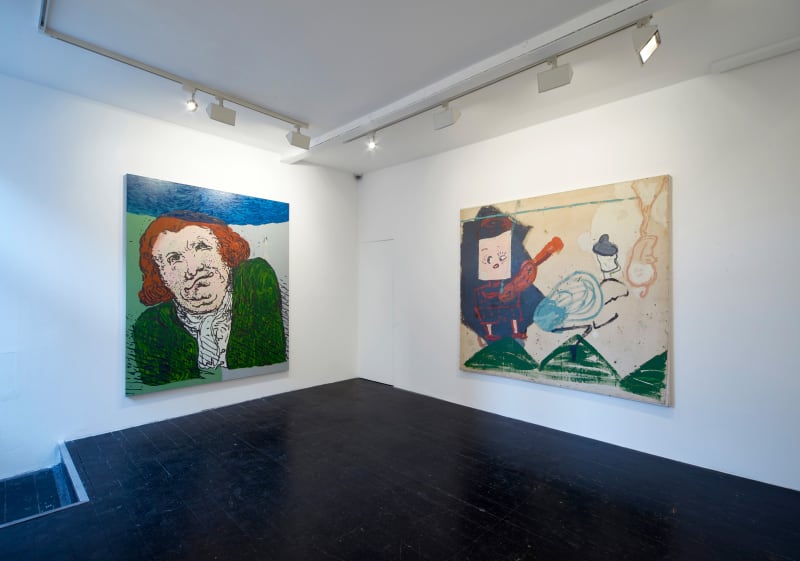nion gallery is pleased to announce Figure.Out, a group exhibition featuring Charlie Billingham, Dale Lewis and Rose Wylie, curated by William Gustafsson. Figure.Out explores the work of three British artists and how their paintings relate to the canon of art history in a contemporary manner.
Charlie Billingham’s work is a nod to old English prints, which have often been viewed as an unappreciated art form. In the works presented, Billingham extracts a particular “crop” from early 19th century satirical prints by Thomas Rowlandson (1756-1827), used as source material, isolating his figures. His aim is to retain the attitude of the original Rowlandson prints while removing the context of the narrative. The vacant coloured-blocked negative space floods the background of Billingham’s paintings thrusting the figures into the foreground, creating an emphasis on the figure’s gaze. This leaves the viewer to decipher the reason for the emotions of the figures presented. What troubles the figure in Man, Thinking? Why is the female in Woman, Crying shedding a tear? We attempt to figure it out.
Working from his memory of real-life experiences, Dale Lewis uses a combination of spray paint, oil and acyclic paint rapidly applied to the canvas displaying themes of society breakdown, poverty, drug and alcohol addiction, illness, disease, death and violence which reoccur in his work. In Cash Converters, his first painting in a smaller size breaking away from his mural scale paintings, Lewis overlays a classical composition on his contemporary mode of painting after taking influence from the Spanish Renaissance painter Bermejo Bartolome’s (1440 – 1501) Pieta of Cannon Luis Despia (1490). Lewis’ painting depicts a married couple he witnessed pawning their mobile phones for drug money at Cash Converters on New Years Eve. The scantily clad couple suggests the “selling of their goods” thus removing the pureness of the Madonna and Child represented in the traditional Pieta produced by Bartolome where Lewis took his influence. The chaotic scene is filled with birds, a fox, coins, cigarettes, and cider cans, on top of a yellow and red (the branding colours of Cash Converters) background, representing the honest reality of the street in London.
In Rose Wylie’s home and studio her works adorn the walls like wallpaper constantly providing a source of inspiration. In Titian Tableau (Woolly Hat) we are treated to a rare occasion where Wylie has refashioned one of these works adding painted collage elements, which have become a signature of her work. Spanning 25 years between working on the painting, Titian Tableau (Woolly Hat) was originally painted in 1991 as part of a three painting series by Wylie in reference to Titian’s (1490-1576) Flaying of Marsyas (1575). This tale is of a musical contest between the satyr Marsyas and god Apollo with the victor deciding the punishment of the loser. A story of stupid pride where Marsyas is ultimately defeated and is resigned to a cruel death via the slow stripping of his flesh. Yet, it was the visual language of Titian’s zigzag composition which interested Wylie the most, encouraging her to make the series of the Titian paintings.
Figure.Out: Charlie Billingham, Dale Lewis & Rose Wylie
Past exhibition
